Wild chamomile is a delightful plant you'll easily recognize when searching for tea. Its daisy-like flowers feature white petals surrounding a bright yellow center. The plant grows 12 to 24 inches tall and thrives in sunny, well-drained areas like meadows and roadsides. Look for finely divided, feathery green leaves that taper to a point. When you crush the leaves or flowers, you'll notice a sweet, apple-like scent. Harvest the flowers in the morning for the best flavor. If you're curious about how to prepare and enjoy this herbal tea, there's plenty more to explore.
Overview of Wild Chamomile

Wild chamomile, often mistaken for its cultivated counterpart, is a charming herb that offers a unique flavor and numerous health benefits. This aromatic plant grows in various regions, thriving in sunny, well-drained areas. When you encounter it, you'll notice its delicate white petals and yellow centers, giving it a daisy-like appearance. It's no wonder you might confuse it with garden chamomile!
When you brew wild chamomile tea, you'll experience a soothing, slightly sweet taste that can be quite delightful. The tea is known for its calming properties, making it an excellent choice for unwinding after a long day. People often turn to wild chamomile for relief from digestive issues, anxiety, and sleep disturbances.
Harvesting wild chamomile can be an enjoyable experience, allowing you to connect with nature while gathering this useful herb. As you explore the outdoors, keep an eye out for this gem, and consider incorporating it into your herbal tea collection.
Not only will you enjoy the flavor, but you'll also benefit from its many potential health advantages. With wild chamomile, you're adding a touch of nature's magic to your daily routine.
Key Identification Features
To easily identify wild chamomile, look for several distinct features. This herb can often be confused with other plants, so knowing what to look for is key.
- Leaves: The leaves are finely divided, resembling feathery, fern-like foliage. They're typically a vibrant green color.
- Flowers: Wild chamomile produces small, daisy-like flowers with white petals surrounding a yellow center. The flowers usually bloom in clusters.
- Height: The plant generally grows between 12 to 24 inches tall, making it relatively easy to spot in meadows or open fields.
- Scent: One of the most notable features is its sweet, apple-like fragrance when you crush the leaves or flowers.
When you observe these characteristics together, you'll have a better chance of correctly identifying wild chamomile.
Habitat and Growing Conditions
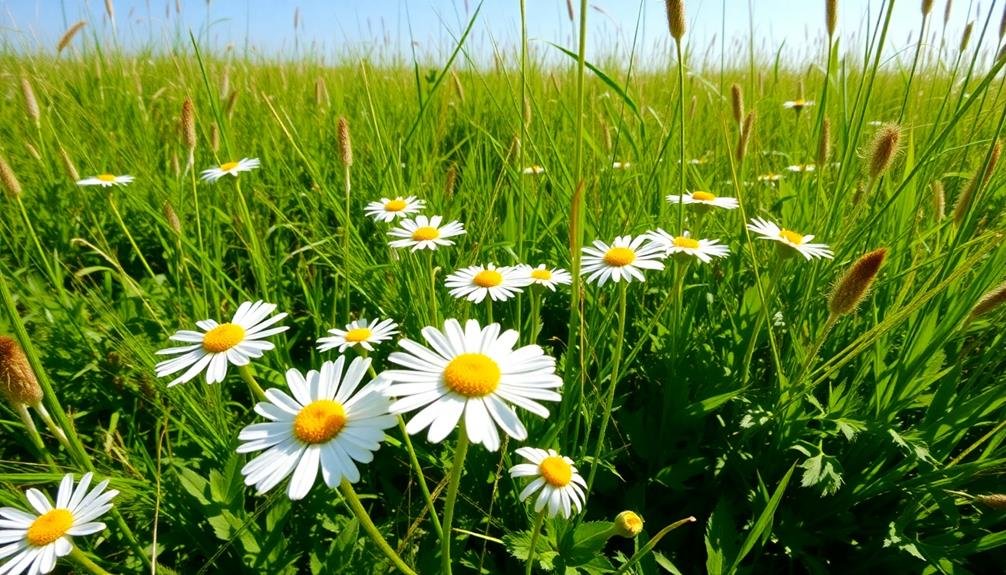
To successfully grow wild chamomile, you'll want to pay attention to its preferred soil type, which is typically well-drained and sandy.
It thrives in full sunlight, so make sure to plant it in a spot that gets plenty of direct light.
Additionally, keep an eye on moisture levels, as wild chamomile prefers moderate watering without becoming waterlogged.
Preferred Soil Type
Chamomile thrives best in well-drained, sandy or loamy soils that are slightly acidic to neutral in pH. If you're looking to grow wild chamomile for tea, it's crucial to provide the right soil conditions to guarantee healthy growth and abundant flowers.
Here are a few key characteristics to bear in mind when preparing the soil:
- Drainage: Make sure the soil drains well to prevent waterlogging, which can harm the roots.
- Texture: Sandy or loamy textures promote aeration and root development, vital for chamomile's growth.
- pH Level: Aim for a pH between 6.0 and 7.0; chamomile prefers slightly acidic to neutral soils.
- Nutrient Content: While chamomile doesn't require overly rich soil, a balanced nutrient profile supports strong plants.
Sunlight Requirements
Providing the right amount of sunlight is key to growing healthy wild chamomile for tea. This plant thrives in full sun, meaning it needs at least six hours of direct sunlight each day. If you want your chamomile to produce the best flavor and aroma, guarantee it's placed in an area that receives ample sunlight.
Here's a quick reference table that outlines the sunlight requirements for wild chamomile:
| Sunlight Exposure | Ideal Conditions | Effects of Insufficient Sunlight |
|---|---|---|
| Full Sun | 6+ hours/day | Stunted growth |
| Partial Shade | 4-6 hours/day | Weak flavor and aroma |
| Total Shade | Less than 4 hours/day | Poor blooming and overall health |
| Container Growth | Rotate for even light | Uneven growth and leggy plants |
| Outdoor Growth | Avoid shaded areas | Increased vulnerability to pests |
When you meet these sunlight needs, you'll not only encourage robust growth but also enhance the overall quality of your tea. So, find that sunny spot and watch your wild chamomile flourish!
Moisture Levels
How much moisture does wild chamomile really need for ideal growth? When you're considering cultivating this aromatic herb, understanding its moisture requirements is essential.
Wild chamomile prefers well-drained soil but still needs consistent moisture to thrive. It's important to strike a balance—too little moisture can stunt growth, while too much can lead to root rot.
Here are some key moisture considerations for wild chamomile:
- Soil Type: Sandy or loamy soils retain moisture without becoming waterlogged.
- Watering Frequency: Water regularly but allow the top inch of soil to dry out between watering sessions.
- Rainfall: Natural rainfall often provides sufficient moisture, but during dry spells, you may need to supplement with additional watering.
- Humidity Levels: Wild chamomile thrives in moderate humidity; extreme dryness can hinder its growth.
Distinguishing From Similar Plants
When you're foraging for wild chamomile, it's essential to distinguish it from similar plants.
Pay close attention to the leaf structure and the differences in flower appearance, as these can help you identify the right species.
Let's break down what to look for to guarantee you're picking the true wild chamomile.
Leaf Structure Comparison
Many people might confuse wild chamomile with other plants, but a close look at the leaf structure can help distinguish it. Wild chamomile leaves are distinct, often featuring a finely divided, feathery appearance. This unique structure sets it apart from similar plants, like daisies or other chamomile varieties, which may have broader or less segmented leaves.
To help you identify wild chamomile more effectively, here are some key characteristics to observe:
- Shape: The leaves are typically lanceolate or elongated, tapering to a point.
- Edges: You'll notice the edges are serrated or jagged, giving them a delicate look.
- Color: The leaves usually display a vibrant green hue, which can be a bit more intense than that of other look-alikes.
- Texture: The surface of wild chamomile leaves has a slightly hairy or fuzzy texture, adding to their distinctiveness.
Flower Appearance Differences
The flowers of wild chamomile are one of its most distinguishing features, setting it apart from similar plants. When you look closely, you'll notice that wild chamomile flowers have a unique daisy-like appearance. Each flower head consists of a central yellow disc surrounded by white petals, typically 10 to 20 in number. This contrast between the bright yellow center and delicate white petals is a key identifier.
To differentiate wild chamomile from other similar plants like oxeye daisy or feverfew, pay attention to the flower's size. Wild chamomile flowers are generally smaller, measuring around 1 to 2 inches in diameter. Additionally, the petals of wild chamomile are often more slender and pointed compared to those of other daisies, giving them a more delicate look.
Another important detail is the growth habit. Wild chamomile flowers usually grow on top of slender, upright stems, while some similar plants may have bushier appearances.
Harvesting Wild Chamomile

To harvest wild chamomile, look for the plants in sunny, open areas, often found in fields or along roadsides. When you identify these flowering beauties, it's time to gather them for your tea. Here's how to make the most of your harvesting experience:
- Choose the Right Time: Harvest chamomile in the morning after the dew has dried, ensuring the flowers are fresh and aromatic.
- Use Sharp Tools: A pair of scissors or garden shears will help you cut the flowers cleanly without damaging the plant.
- Select Flowers Wisely: Pick only the fully open flowers, as they contain the highest concentration of essential oils and flavor.
- Be Mindful of Sustainability: Only take what you need and leave plenty for the plant to regrow, ensuring future harvests.
Harvesting wild chamomile can be a rewarding experience, connecting you with nature while providing you with a delightful ingredient for your tea.
Just remember to enjoy the process and respect the environment as you gather this lovely herb. Happy harvesting!
Preparing for Tea Brewing
Once you've harvested your wild chamomile, you're ready to prepare it for tea brewing. Start by rinsing the flowers gently under cool water to remove any dirt or small insects.
Lay them out on a clean towel or paper towel to dry completely; this step is essential to avoid diluting your tea's flavor.
Next, you can choose to use the flowers whole or break them apart for a stronger infusion. If you prefer, you can also mix in some dried leaves for added flavor.
Measure out about two teaspoons of dried chamomile flowers per cup of water. If you're brewing a larger batch, adjust the quantity accordingly.
Now, boil water in a kettle, then let it cool for a minute or two. Pour the hot water over the chamomile in your teapot or steeping device.
Allow it to steep for about five to ten minutes, depending on your taste preference. The longer you steep, the stronger the flavor will be.
Once it's ready, strain the tea into your favorite cup, and enjoy the soothing aroma and taste of your homemade wild chamomile tea.
Benefits of Wild Chamomile Tea

Enjoying a warm cup of wild chamomile tea not only soothes your senses but also offers a range of health benefits. This herbal infusion is packed with properties that can enhance your well-being.
When you sip on this delightful tea, you're not just treating yourself to a comforting experience—you're also nourishing your body.
Here are some key benefits of wild chamomile tea:
- Promotes Relaxation: Chamomile is known for its calming effects, helping reduce stress and anxiety.
- Aids Digestion: Drinking chamomile tea can alleviate digestive issues, such as bloating and indigestion.
- Supports Sleep: The natural sedative properties make it a great bedtime drink to encourage restful sleep.
- Boosts Immune System: Chamomile contains antioxidants that can strengthen your immune response.
Incorporating wild chamomile tea into your daily routine can be a simple yet effective way to enhance your overall health.
Frequently Asked Questions
Can Wild Chamomile Be Grown Indoors or in Pots?
Yes, you can grow wild chamomile indoors or in pots! Just make certain they receive plenty of sunlight, use well-draining soil, and water them regularly. With proper care, you'll enjoy fresh chamomile right at home!
Is Wild Chamomile Safe for Pets and Livestock?
Yes, wild chamomile is generally safe for pets and livestock. However, always monitor their reactions and consult your veterinarian if you're unsure. Some animals may have sensitivities, so it's best to be cautious.
What Time of Year Is Best for Harvesting Chamomile?
You should harvest chamomile in late spring to early summer when the flowers are fully open. This is when their aromatic oils are at their peak, ensuring the best flavor and potency for your tea.
How Can I Store Dried Wild Chamomile Leaves?
To store dried wild chamomile leaves, keep them in an airtight container, away from light and moisture. A dark, cool place works best. This'll help maintain their flavor and potency for future use.
Are There Any Side Effects of Consuming Wild Chamomile Tea?
Consuming wild chamomile tea can cause mild side effects like drowsiness or allergic reactions in some individuals. It's best to start with small amounts to see how your body reacts before increasing the dosage.
In Summary
In summary, wild chamomile is a delightful herb to identify and brew for tea. By recognizing its key features and understanding its habitat, you can confidently harvest this fragrant plant. Always be certain to distinguish it from similar species to guarantee safety. Once you've gathered your wild chamomile, preparing it for tea is simple and rewarding. Enjoy the soothing benefits of your homemade wild chamomile tea, knowing you've connected with nature in a meaningful way.

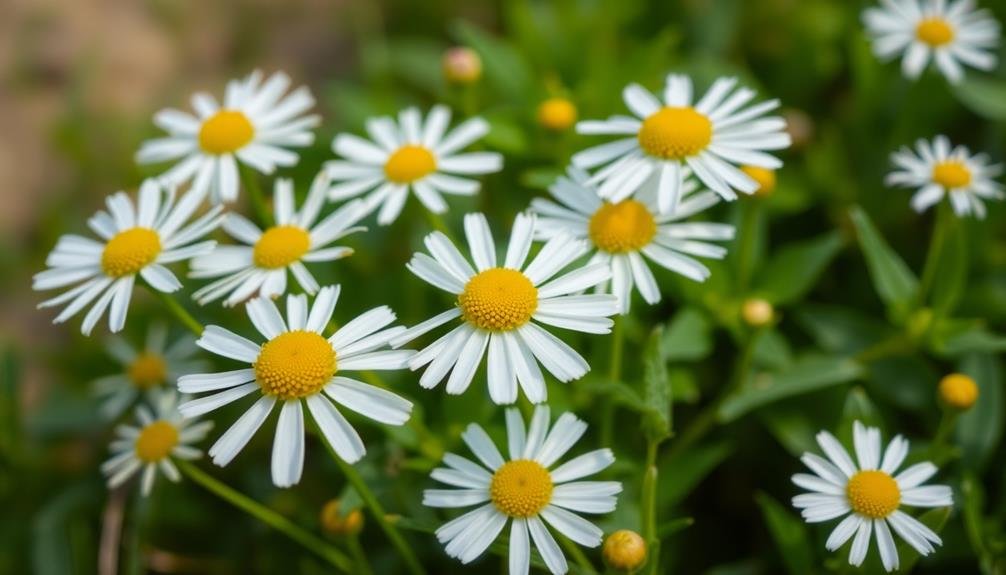
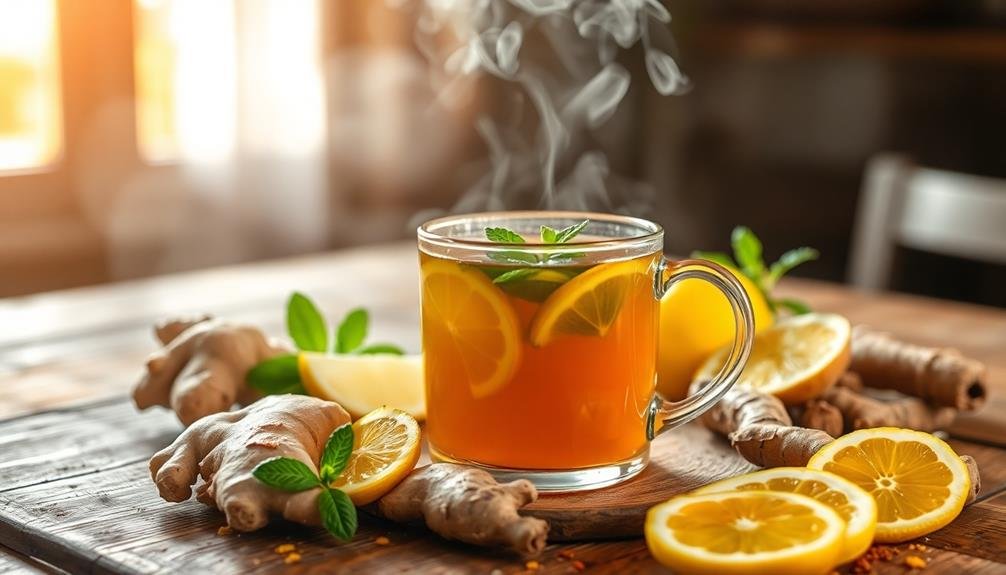
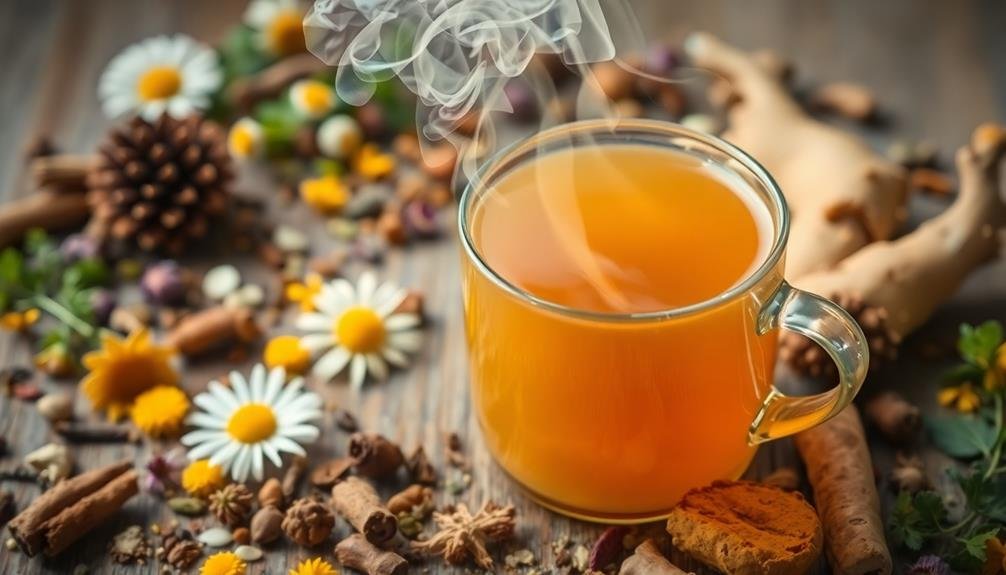
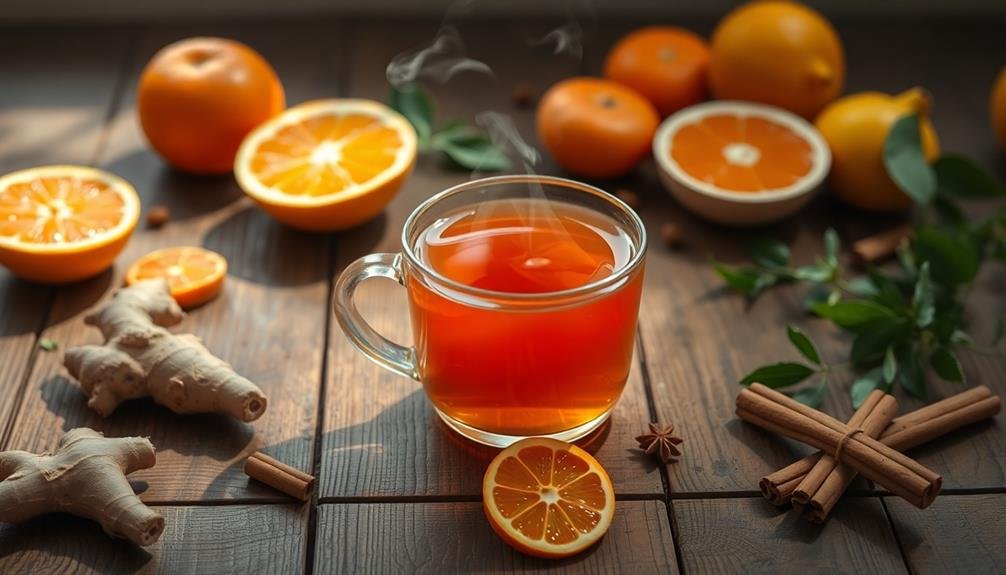
Leave a Reply